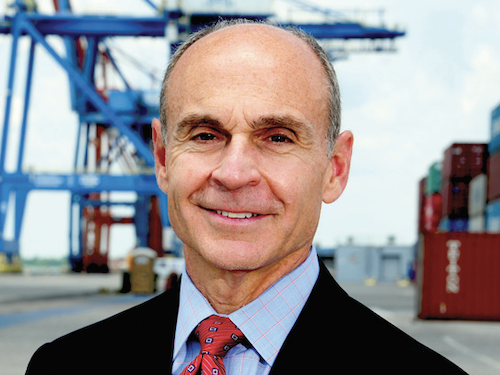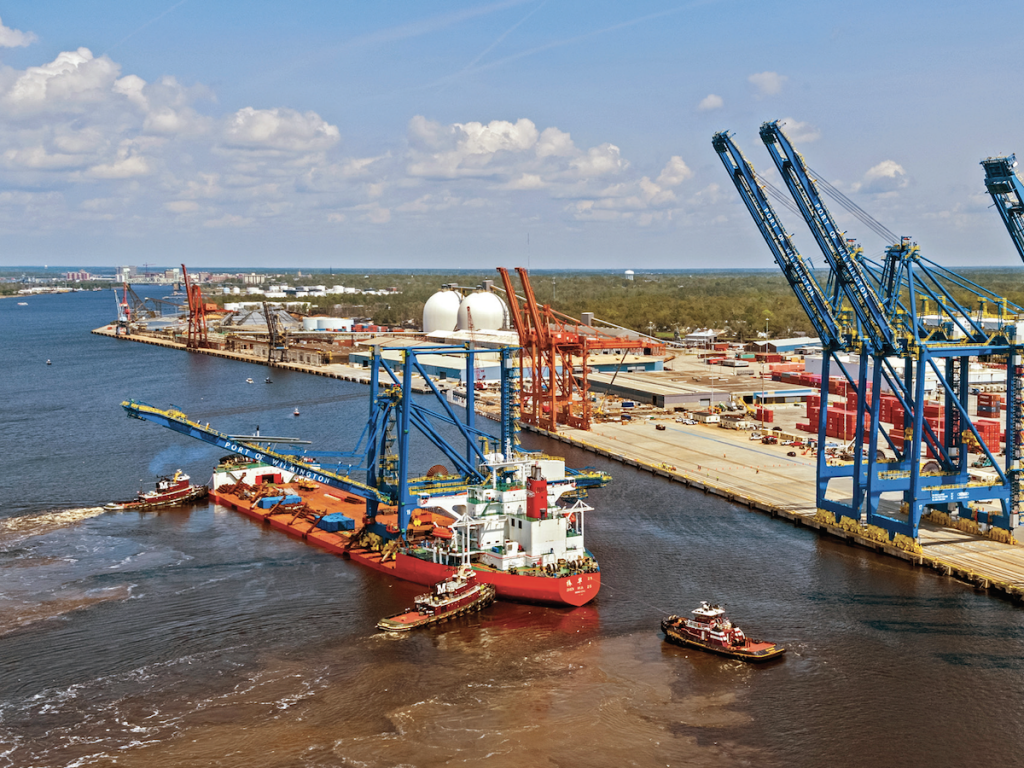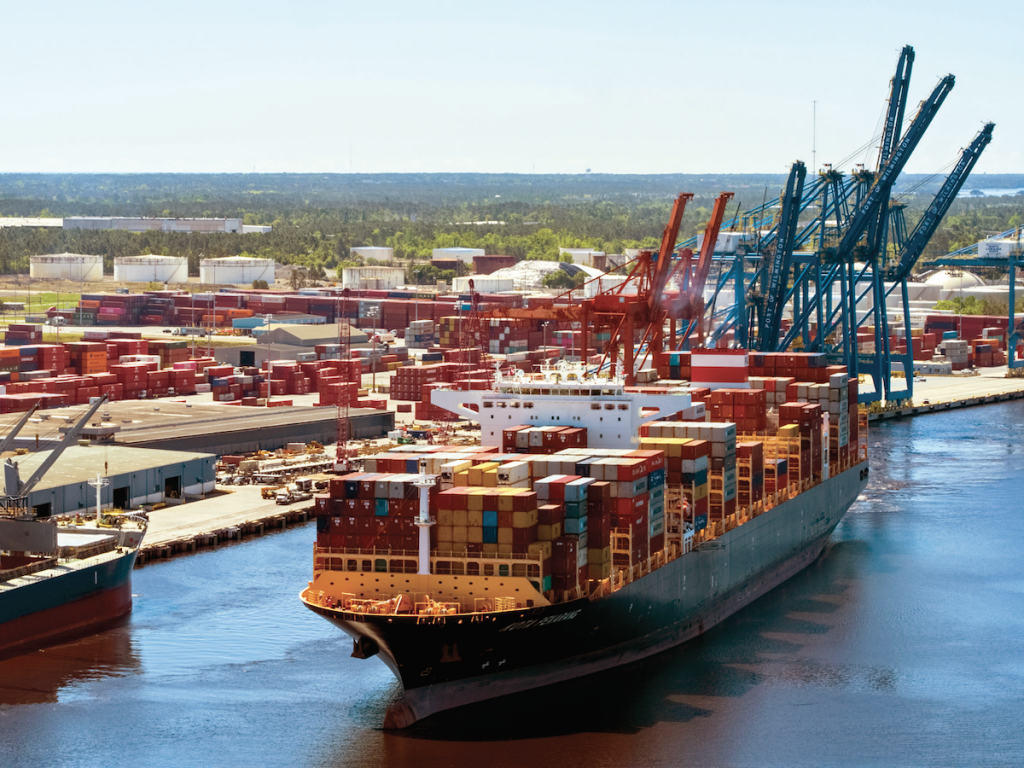With increasing volumes of inbound and outbound cargos shifting to its Port of Wilmington from other U.S. Southeast gateways, the North Carolina State Ports Authority is advancing wide-ranging enhancements while continuing its laser focus on unencumbered efficiencies.
“It’s mostly the normal transition of freight migrating through what should be its natural gateway using North Carolina ports.” Paul J. Cozza, executive director of the North Carolina State Ports Authority, told AJOT. “That’s good stuff.”
Wilmington’s latest containerized cargo numbers don’t tell the full positive story, as destruction wrought by Hurricane Florence in September 2018 put a hiccup in results for the port’s most recent fiscal year, ended June 30, 2019.

Despite a swift recovery from the storm, the port’s fiscal 2019 containerized cargo handlings figure slipped almost 5 percent, to 306,000 twenty-foot-equivalent units, from the record volume of 322,391 TEUs in fiscal 2018 – up 38 percent from fiscal 2017. That led some observers to dub Wilmington the fastest-growing containerport on the East Coast.
Obviously, Cozza said he was thankful this past September’s scrape with Hurricane Dorian brought far fewer negative ramifications than Florence.
“The story continues in the right way as we keep the original strategy going forward of not only growth but also modernizing of the facilities,” said Cozza, a former Maersk Line executive who is now in his sixth year as North Carolina Ports leader.
“We’re doing a real terminal modernization on our container side,” he said. “Our berth work is just about done.”
The port’s Berth 7 reconstruction project is on schedule to be completed by the end of calendar 2019, to provide 2,600 feet of contiguous berth space, so that the Port of Wilmington will be able to handle two neo-Panamax vessels at the same time.
Earlier this year, the Port of Wilmington got delivery of its third neo-Panamax gantry, joining two similar units received in 2018 plus another four somewhat smaller ship-to-shore cranes.

In April, Wilmington received its first call from a containership with a capacity of 12,000 TEUs or more, with the arrival from Asia of the Kota Pekarang, operated by Zim Integrated Shipping Services in partnership with the 2M Alliance of Maersk Line and Mediterranean Shipping Co.
Now under construction, with a targeted completion date in early spring, is a new yard for refrigerated containers. It is to have racking systems, three racks high, with ability to handle more than 500 reefer containers at a time.
Much of the temperature-controlled cargo activity flows through the on-port facility of Port of Wilmington Cold Storage, opened in 2016 under a public-private partnership. Cozza reported that the facility is at 85 percent to 90 percent utilization and continues to expand.
The Port of Wilmington overall has almost quadrupled its refrigerated container lift over the last four years, led by inbound chilled produce and outbound proteins, including chicken and pork, as well as sweet potatoes.
“We expect that to continue to grow this year,” Cozza said. “That’s why we’re doing our new reefer yard, because we keep hearing the demand is there.”
Grain imports and wood pellet exports are among other commodities enjoying heightened movement at the Port of Wilmington.
“We’re seeing a big increase of inbound grain here in Wilmington because of the heavy rains and flooding they’re seeing in the Midwest.” Cozza said, looking out his office window at a grain vessel from South America. “We’re expecting to see continued heavy growth this year.”
At the same time, the Enviva Partners LP wood pellet export terminal opened on the port in 2016 is teeming with activity.
By yearend, the port is to kick off improvements to its gate and container interchange systems, which should help further reduce already enviable typical truck turn times of 18 minutes for drop-offs and 32 minutes for dual moves.
“We have already invested more than $200 million over past four years, with another $100 million to $150 million to be put into infrastructure over the next 18 months,” Cozza said. “All of this is set up so that it doubles our functional capacity on the container side to be able take at least up to 1 million TEUs a year.” The port’s current annual capacity is about 600,000 TEUs.
Augmenting the port channel’s ability to accommodate larger containerships is critical to expanding Wilmington’s throughput, and port officials in July submitted a feasibility study to U.S. Army Corps of Engineers for deepening the Cape Fear River channel to 47 feet, which Cozza termed “optimal depth for us.”
In addition, January completion is anticipated for a second-phase turning basin endeavor to allow 1,200-foot-long vessels with capacities of as many as 14,000 TEUs to call the Port of Wilmington.

“That’s really exciting,” Cozza said.
Furthermore, low Duke Power cables over the channel south of the port, posing potential future air draft limitations, are to be raised by the end of November, bringing air draft to 211 feet, putting Wilmington in a favorable position compared with other Southeast ports that face bridge clearance restrictions, according to Cozza.
Yet another development contributing to efficient cargo movement is the Queen City Express intermodal train service to Charlotte. The service, initiated in 2017 to transport double-stacked containers from the port to the Charlotte hub of CSX, was upgraded in July to an overnight product available seven days a week.
“Nobody else has a train like this that goes directly into the Charlotte region, so we’re really excited about this,” Cozza said. “Next to only Atlanta, the Charlotte area is the biggest economic hub in the Southeast.”
The Charlotte metropolitan area is home to more than 2.5 million residents, nearly half the population of greater Atlanta.
“We’re already seeing a big pickup of business on this,” Cozza said of the Queen City Express. “It’s a whole new thing that’s getting a lot of interest from customers.”
About 100 miles northeast of Wilmington, North Carolina Ports’ Port of Morehead City, which maintains its focus on bulk and breakbulk cargos, has just welcomed a new Liebherr multipurpose general cargo crane.
Not including private Nutrien Ltd. phosphate operations at Morehead City, North Carolina Ports has doubled its business at the Port of Morehead City since 2014, to nearly 1.1 million tons in the fiscal year ended June 30.
“We continue to see some real growth there,” Cozza said, “which has been really exciting.”





